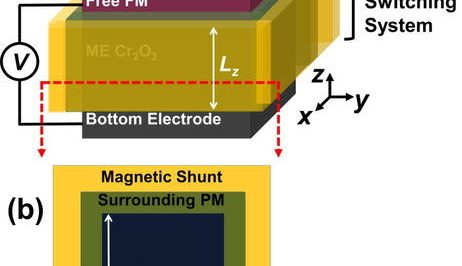Chromia: a candidate for DRAMs?
May 08, 2018
on
on

The ongoing miniaturization of semiconductor memory cells is losing momentum. They are based on transistors and use electric fields to store information. Magnetic fields can also store data, a new design makes use of the magnetoelectric effect to switch the magnetic properties of a material using an electric field. This design has the advantages of simplicity, small size and low energy consumption.
The proposed new switching element made of chromia (Cr2O3) is magnetoelectric and has the potential to replace flash mass storage for computer systems. The researchers, Victora and Ahmed, have proposed a design for a storage cell based on chromia, which does not require an externally applied magnetic field and switches state purely using electrical control.
The chromia memory cell will be encircled with magnetic material producing an effective magnetic field through quantum mechanical coupling to chrome magnetic moments. The arrangement will prevent stray magnetic fields affecting neighboring cells. In principle the structure is suitable for extreme miniaturization. The increased surface area of the interface compared to its volume enhances its operational properties. This is in contrast with semiconductor cells which demonstrate increased leakage currents and heat loss as their structure get smaller. Victora and Ahmed together with materials specialists plan to develop the concept to build and test a physical device which could one day replace computer semiconductor DRAM storage.
Mass storage with Cr2O3 cells will most likely take years to optimize. One big problem identified so far is its sensitivity to temperature; calculations indicate that reliability issues will be encountered at 30°C room temperature.
The proposed new switching element made of chromia (Cr2O3) is magnetoelectric and has the potential to replace flash mass storage for computer systems. The researchers, Victora and Ahmed, have proposed a design for a storage cell based on chromia, which does not require an externally applied magnetic field and switches state purely using electrical control.
The chromia memory cell will be encircled with magnetic material producing an effective magnetic field through quantum mechanical coupling to chrome magnetic moments. The arrangement will prevent stray magnetic fields affecting neighboring cells. In principle the structure is suitable for extreme miniaturization. The increased surface area of the interface compared to its volume enhances its operational properties. This is in contrast with semiconductor cells which demonstrate increased leakage currents and heat loss as their structure get smaller. Victora and Ahmed together with materials specialists plan to develop the concept to build and test a physical device which could one day replace computer semiconductor DRAM storage.
Mass storage with Cr2O3 cells will most likely take years to optimize. One big problem identified so far is its sensitivity to temperature; calculations indicate that reliability issues will be encountered at 30°C room temperature.
Read full article
Hide full article


Discussion (0 comments)